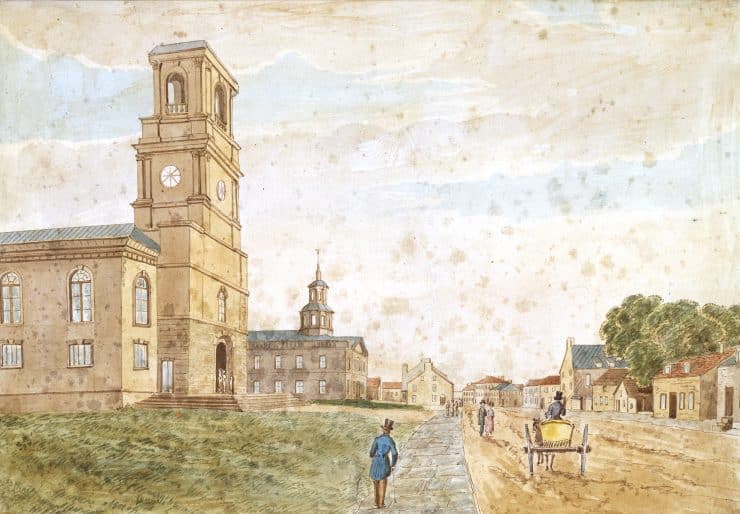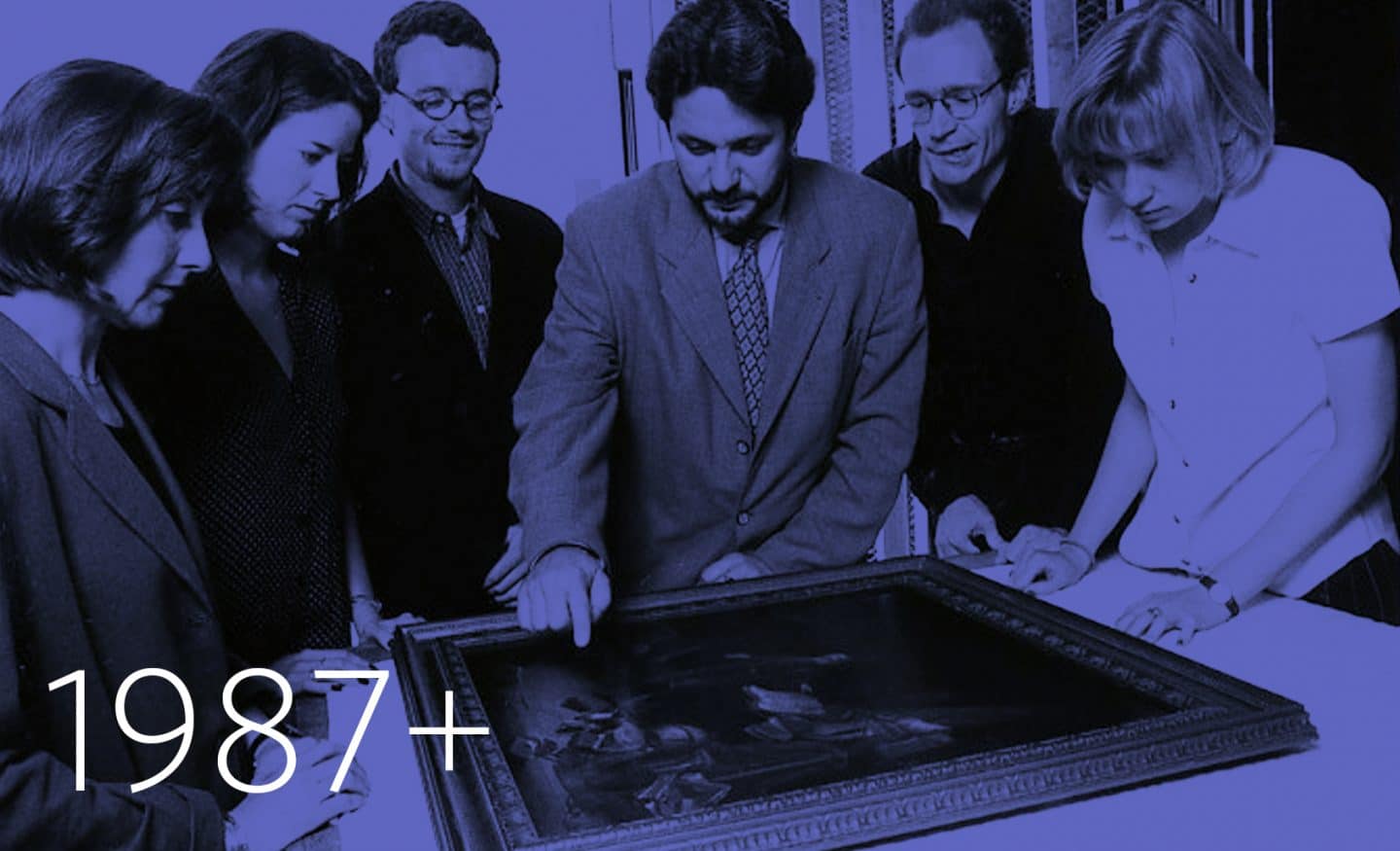
James Pattison Cockburn, View North along King Street near St. George’s Church, 1829, watercolour on paper. Gift of Chancellor Agnes Benidickson, 1987 (30-091)

Chancellor Agnes Benidickson, the niece and namesake of Agnes Etherington and long-time patron of the gallery, donates James Pattison Cockburn’s View North along King Street near St. George’s Church (1829). Since the 1970s, the Agnes has actively collected topographical watercolours and drawings by British officers and their wives, in recognition of Kingston’s military history.
Local artist Joyce Putnam also donates paintings by her friend A. Y. Jackson, with further gifts in subsequent years, building a remarkable body of landscapes in our holdings by Group of Seven members and their colleagues.
The Agnes undergoes renovation to create the Justin and Elisabeth Lang Gallery of African Art in the former sculpture terrace and to give a “facelift” to the main foyer and visitor services. At the opening, the Quammie Williams Ensemble presents traditional music and dance from Mali, Senegal and Ghana.
The Agnes also acquires eight oil paintings by Joseph Wright of Derby. Brought to Canada in 1914 by descendants of the original British owner, these landscapes were under threat of permanent export. Recognizing the value of Derby’s work on an international level, Drs. Alfred and Isabel Bader contributed funding to the purchase, supplemented by a grant under the Cultural Property Export and Import Act.
Telling Images: Selections from the Bader Gift of European Paintings to Queen’s University closes at the Agnes before circulating in six provinces. The exhibition is guest curated by David McTavish, former Queen’s Art History professor then at the Art Gallery of Ontario. Two years later, McTavish returns to Queen’s as head of Art History, and later becomes the Agnes’s director. In 2016, the David McTavish Art Study Room is launched in his memory, fittingly expanding the Agnes’s capacity for academic engagement.
Seeing Red, curated by Michael Bell, features contemporary artists of Indigenous ancestry, including Bob Boyer, Joane Cardinal-Schubert, Edward Poitras and Jane Ash Poitras. It is followed in the next year by Reclaiming History: Robert Houle, Carl Beam and Edward Poitras. Carl Beam’s Columbus Suite (1989), Edward Poitras’s Anglais in Edom (1990) and Robert Houle’s Lost Tribes #6 and #8 (1989) are all purchased in 1990.
The McLean Foundation (Toronto) donates funds to purchase the entire collection of theatre portraits by Kingston artist Grant Macdonald, from Laurence Olivier to Robertson Davies. Another body of significant acquisitions is featured in Gifts from Herbert Bunt, recognizing the ongoing donations of contemporary works from this Queen’s alumnus. By 2017, Bunt has gifted some 289 pieces, many representing formative stages in artists’ careers.
Also in this year, the inaugural Janet Braide Memorial Award for outstanding contribution to scholarship in the field of Canadian art history is presented to scholar John O’Brian. The award becomes the Janet Braide Memorial Fund in 2001, dedicated to supporting programs and exhibitions in Canadian historical art.
Looking back at 1941 when artists from across the country met at Queen’s for the first ever Conference of Canadian Artists (the “Kingston Conference”), the Agnes organizes another national conference. Attendees explore the artist’s place within shifting cultural and political power structures and address the urgent need for full recognition of cultural diversity. “1941” is a small exhibition of works by artists who attended the first Kingston Conference and Digital Highways demonstrates continuities and differences in fine art traditions set fifty years apart.
Prince Charles visits the Agnes during the Queen’s sesquicentennial to address the convocation and receive an honourary degree. Drs. Alfred and Isabel Bader also donate seventeen paintings this year, including El Greco’s Adoration of the Shepherds (around 1567).
“All That Glitters” is the first Agnes program funded by the new David Bain Memorial Fund (later David and Patti Bain). With a roster of expert talks on silver, a cocktail buffet and a bus trip to view the silver collection at Kingston’s Royal Military College, the program is quickly subscribed. Participants are invited to bring a silver piece for appraisal by keynote speaker Christopher Hartop of Christie’s New York. Established in 1991 in memory of Kingston interior designer David Bain, the fund continues to support public events focused on the decorative arts.
Hear to See II: Looking at Contemporary Art builds on the success of the first Hear to See in 1990. Education Officer Jeri Harmsen curates a show of six contemporary works from the collection, by Michael Snow, Katja Jacobs, Richard Gorenko, Milly Ristvedt, Carl Beam and Betty Goodwin. Using state-of-the art telephone technology, visitors listen to commentary and interviews with the artists. The exhibition wins the Ontario Association of Art Galleries Educators’ Award, reflecting the Agnes’s leadership in its use of in-gallery technology.
In September, renowned Canadian artist Alex Colville gives a talk, “Artist as Magician: Alex Colville,” to a packed house in conjunction with an exhibition of his drawings on tour from the Owens Art Gallery, Mount Allison University. Earlier in the year, Colville’s watercolour Three Weeds (1958) is featured in the Recent Acquisitions Corner, a mid-1990s exhibition series of singular collection highlights. The Agnes acquires its first figural painting by Colville, Nude on a Rug (1954), in 2012—an eerie, intimate portrait of the artist’s wife.
The Female Imaginary features works that speak back to patriarchy and offer inventive speculation on equitable alternatives. After a day of dialogue at the related symposium “Feminist Practice in the Visual Arts,” Winnipeg-based artist duo Shawna Dempsey and Lorri Millan perform The Thin Skin of Normal. Part of a series of feminist group exhibitions curated by Jan Allen, The Female Imaginary is followed by Rx: Taking Our Medicine and, in 1996, Fertile Ground—by which time Allen occupies a newly created position at the Agnes, Curator of Contemporary Art.
The capital campaign for gallery expansion is launched with the exhibition Wisdom, Knowledge and Magic: The Image of the Scholar in Seventeenth-Century Dutch Art. Seventeen works are lent by Drs. Alfred and Isabel Bader, along with others from the National Gallery of Canada, Art Gallery of Ontario, Metropolitan Museum of Art, and others. The exhibition is prepared by Dr. Volker Manuth, Bader Chair in the Department of Art, in collaboration with graduate students. Described as “unique in its ambitiousness in this country” for a student-organized exhibition, Wisdom, Knowledge and Magic and its catalogue mark a major step in contextualizing paintings in The Bader Collection.